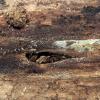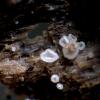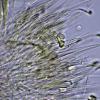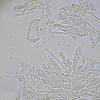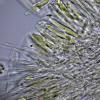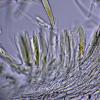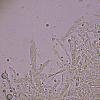
08-12-2025 18:59
 Lothar Krieglsteiner
Lothar Krieglsteiner
.. found by a seminar-participant, I do not know t

08-12-2025 21:04
Mark Stevens"Hello everyone,I'm relatively new to microscopy (

08-12-2025 17:37
 Lothar Krieglsteiner
Lothar Krieglsteiner
20.6.25, on branch of Abies infected and thickened

07-12-2025 16:07
Arnold BüschlenHallo, ich habe in einer Moos-Aufsammlung (epiphy

16-03-2014 22:00
Hello,I found this species a few months ago but ha

08-12-2025 13:39
Thomas Læssøehttps://svampe.databasen.org/observations/10572899

05-12-2025 17:33
 Bruno Coué
Bruno Coué
Bonjour, je serais heureux de recueillir votre avi
¿Hyaloscypha?
Josep Torres,
17-06-2025 14:23
A probable Hyaloscypha from last June 1st, sprouting on the debarked wood of a sloping trunk on the deciduous forest floor, where the most abundant species in the area were hazel (Corylus) and oak (Quercus).
Whitish apothecia measuring between 0.20 and 0.50 mm in diameter.
Marginal hairs with pointed tips, short septa at their bases, and measuring (55.9) 60.3 - 92.8 (102.3) × (3.3) 3.4 - 5.3 (5.6) µm.
Exciple hyphae arranged more or less parallel, measuring (9.3) 12.5 - 16.7 (18.4) × (4.5) 4.8 - 6.5 (8.9) µm.
Octosporic asci, with a timid reaction of their tiny apical apparatus to the Melzer, and measuring (39.6) 40.3 - 44.8 (46.2) × (5) 5.2 - 5.7 µm.
Free ascospores cylindrical, with a somewhat pointed end and measuring in water:
(6.4) 6.6 - 8.4 (8.8) × (1.5) 1.6 - 2.2 (2.3) µm
Q = (3.2) 3.3 - 4.6 (5) ; N = 24
Me = 7.4 × 1.9 µm; Qe = 3.9
And the mature spores inside the ascus have very similar measurements: (7.2) 7.23 - 8.4 × (1.7) 1.71 - 2.06 (2.1) µm.
Based on their characteristics, my first choice would be Hyaloscypha, and taking into account the substrate, perhaps even Hyaloscypha daedaleae or Hyaloscypha quercina, but it turns out that in both cases they have a spore width greater than my suggestion. I have also been unable to find any other option within the genus with such narrow spores.
Any feedback from you would be welcome.
Thank you very much in advance.
Best regards.
Hans-Otto Baral,
17-06-2025 17:52

Re : ¿Hyaloscypha?
You have no photos fresh in water? I see croziers and would compare H. fuckelii var. fuckelii.
Josep Torres,
18-06-2025 07:49
Hans-Otto Baral,
18-06-2025 08:53

Re : ¿Hyaloscypha?
Water alone is not sufficient. I cannot see any living cells on this photo :-(
Josep Torres,
19-06-2025 07:59
Re : ¿Hyaloscypha?
Hello Zotto.
Unfortunately, there were few live apothecia in the material I collected, and the only images I was able to obtain of an apothecium that appeared to be in better condition were taken with the Melzer.
Now the material has been through the dryer and is exsiccated. I always do this when I have microscopy available, just to avoid bacterial contamination, which could cause problems if I have to resort to molecular analysis.
Still, thank you for bringing me closer to a specific species, although it might be wisest to leave the subject as "cf."
Best regards.
Unfortunately, there were few live apothecia in the material I collected, and the only images I was able to obtain of an apothecium that appeared to be in better condition were taken with the Melzer.
Now the material has been through the dryer and is exsiccated. I always do this when I have microscopy available, just to avoid bacterial contamination, which could cause problems if I have to resort to molecular analysis.
Still, thank you for bringing me closer to a specific species, although it might be wisest to leave the subject as "cf."
Best regards.

